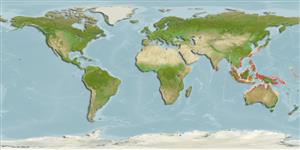>
Callionymiformes (Dragonets) >
Callionymidae (Dragonets)
Etymology: Callionymus: Greek, kallion, comparative of kallos = beautiful + Greek, onyma = name; with a better name .
More on author: Bleeker.
Environment: milieu / climate zone / depth range / distribution range
पारिस्थितिकी
समुद्री; खारा ड़िमरसल; गहराई सीमा 0 - 8 m (Ref. 48636). Tropical
Eastern Indian Ocean and Western Central Pacific.
आकार / वज़न / Age
Maturity: Lm ? range ? - ? cm
Max length : 6.5 cm TL पुल्लिंग / अलिंग; (Ref. 48636)
Inhabits sand and mud flats, mostly estuarine or near rivers (Ref. 48636).
Life cycle and mating behavior
Maturities | पुनरुत्पत्ति | Spawnings | Egg(s) | Fecundities | लार्वा
Randall, J.E. and K.K.P. Lim (eds.), 2000. A checklist of the fishes of the South China Sea. Raffles Bull. Zool. Suppl. (8):569-667. (Ref. 36648)
IUCN Red List Status (Ref. 130435)
Threat to humans
Harmless
Human uses
साधन
Special reports
Download XML
इंटरनेट स्रोत
Estimates based on models
Preferred temperature (Ref.
123201): 25.5 - 29.3, mean 28.8 °C (based on 1304 cells).
Phylogenetic diversity index (Ref.
82804): PD
50 = 0.5000 [Uniqueness, from 0.5 = low to 2.0 = high].
Bayesian length-weight: a=0.00912 (0.00408 - 0.02036), b=2.77 (2.59 - 2.95), in cm total length, based on LWR estimates for this Genus-body shape (Ref.
93245).
Trophic level (Ref.
69278): 3.2 ±0.4 se; based on size and trophs of closest relatives
लौटाव (Ref.
120179): ऊंचा, न्यूनतम जनसंख्या दुगनी समय अवलागत 15 महीने। (Preliminary K or Fecundity.).
Fishing Vulnerability (Ref.
59153): Low vulnerability (10 of 100).
